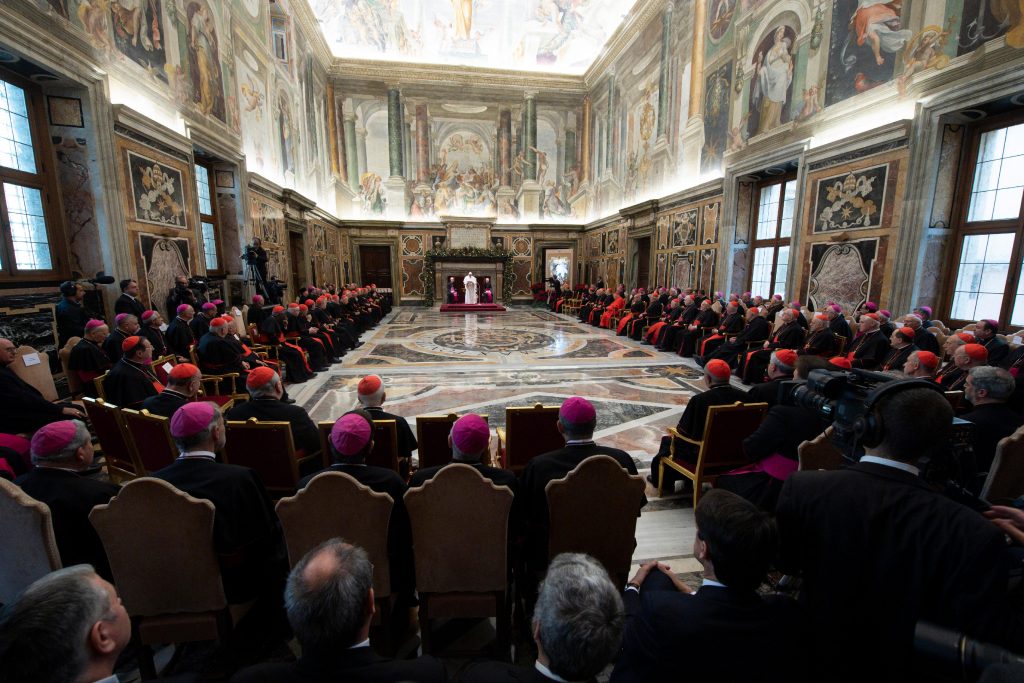ROME — When Pope Francis was elected more than six years ago, one of the key things the cardinals thought they were voting for was a thorough reform of the Roman Curia, meaning the central administrative bureaucracy in the Vatican.
In part, that was a reaction to scandals that plagued the Vatican during the Pope Emeritus Benedict XVI years, including: The Hollywood-esque “Vatileaks” affair, in which the butler actually did it; the bungled rehabilitation of a Holocaust-denying traditionalist bishop; various sexual abuse and financial meltdowns; and a surreal soap opera in which the head of the Vatican security force was accused of framing the editor of the newspaper of the Italian bishops’ conference for political reasons through an alleged case of gay harassment.
Cardinals felt the train had gone off the rails in Rome, and they wanted somebody to make it run on time.
In part, however, the push for reform had deeper roots, stretching back to the Second Vatican Council (1962-65) and its vision of a more participatory Church, one in which all the power in the ecclesiastical system wasn’t concentrated in Rome.
One of the first things Francis did was to establish a council of cardinal advisers from around the world, which came to be known as the “C9” (now the “C6” after three of its members were dismissed), whose mission was to prepare a sweeping reform of the curia.
It has met at least four times a year ever since, 29 times in all, and the pope has sat in on virtually all those sessions.
Now, the long-awaited product of all that time and effort is set to appear in the form of a new apostolic constitution for the curia titled “Praedicate Evangelium” (“Preach the Gospel”).
A draft of the document is currently in the hands of local bishops’ conferences around the world and a variety of other bodies for consultation, and it’s expected to be formally issued by Francis soon, perhaps as early as June 29, the feast of Sts. Peter and Paul.
According to reports, the biggest novelty will be the creation of a “super-dicastery,” meaning an expanded and more powerful new Vatican department, dedicated to evangelization, which will result from merging two existing bodies.
It will include the Congregation for the Evangelization of Peoples, also known as “Propaganda Fidei,” tasked with overseeing “missionary territories;” and the Pontifical Council for the Promotion of the New Evangelization, created in 2010 by Benedict to confront the rapid secularization of Western countries.
That choice has raised eyebrows in some quarters, since it could be seen as playing down the importance of the Congregation for the Doctrine of the Faith, the Vatican’s traditional doctrinal watchdog agency, which over the years has been known informally as “La Suprema” — the “supreme” department.
While awaiting the broader overhaul, Francis hasn’t been idle over the last six years.
He’s approved a large number of smaller-scale reorganizations, created a series of new departments for specific purposes (such as the Secretariat for the Economy and the Pontifical Commission for the Protection of Minors, for instance) and issued a host of laws that have reshaped Vatican rules and procedures on a variety of fronts.
Most recently, last week he issued a new set of norms governing the reporting of clerical sexual abuse and cover-up and outlining how a preliminary investigation of those charges is supposed to work.
If that past is prologue, what can we expect once “Praedicate Evangelium” is official?
First, the mere fact that a department has been created doesn’t mean reform has arrived.
Most observers, for instance, would say that the Secretariat for the Economy, envisioned in 2014 as the tip of the spear for financial reform, hasn’t really lived up to its potential. Today, its once-broad powers have been circumscribed, and it still doesn’t have a new leader after former Cardinal George Pell was charged and then convicted of “historic sexual offenses” in his native Australia.
In the small world of the Vatican, personnel is policy, and without the right leadership, no structure, new or old, accomplishes much.
Second, Francis’ concept of “reform” has been a mix of the new with the old, in ways that many observers believe generally favors the latter.
Operationally, the single greatest result of his flurry of activity over the past six years has been to accent the predominance of the Secretariat of State, the 800-pound gorilla on the Vatican scene that exercises a coordination and oversight role over all the other departments.
Ironically, perceptions that too much power had been concentrated in the Secretariat of State, and that an “old guard” imbedded in its culture represented an obstacle to any real change, were a large chunk of the original impulse for reform.
The practical result of the Francis era as it now stands, however, is that the Secretariat of State has more real power than at any time since the time of Pope Pius XII.
(That’s true of the new sex abuse norms too, which require other Vatican departments handling cases to inform the Secretariat of State and also assigns State direct authority over papal diplomats.)
It remains to be seen if “Praedicate Evangelium” will mark a break with those patterns, or, as seems more likely, reinforce them.
If so, Italians may be tempted to see Francis’ curial reform as a classic case of what they call “una riforma gattopardesca,” referring to Lampedusa’s celebrated novel “The Leopard” and its most famous line, “Everything must change, so that everything may remain the same.”
John L. Allen Jr. is the editor of Crux.
SPECIAL OFFER! 44 issues of Angelus for just $9.95! Get the finest in Catholic journalism with first-rate analysis of the events and trends shaping the Church and the world, plus practical advice from the world’s best spiritual writers on prayer and Catholic living, along with great features about Catholic life in Los Angeles. Subscribe now!

